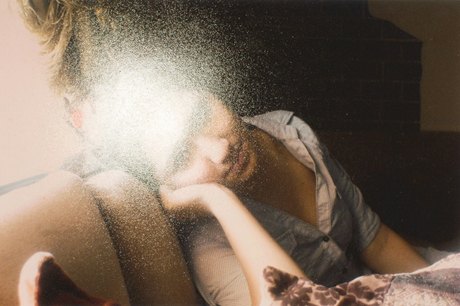Unknown Quantities

Saudi Arabia. Jeddah. A Saudi girl watches TV at home. 2009 *A print of the image has been rephotographed under a reflective light to partially conceal identity. Photograph: Olivia Arthur
“The name causes a lot of confusion. Every day people come to the shops on either side of us and ask ‘when is the fish market opening?’ They are disappointed to learn that it is actually a gallery.”
Philipp Ebeling, co-owner of the recently opened Fishbar Gallery, is telling me the story behind the curiously named enterprise. In its previous life, it was a Vietnamese restaurant left empty for years and in a state of near collapse but Philipp saw potential and, with his partner and colleague Olivia Arthur, they moved in and begun the long process of renovation.
“We were struggling to think of an appropriate name that did not contain the work ‘photography’. One day we pulled down the neon sign above the door and behind it revealed the words ‘Fish Bar’ and it just stuck.”
And so another ramshackle, disused nook of Hackney is transformed into a thriving artistic nest and, from the end of April, it will be showcasing extraordinary images from across the Arab world.
Olivia, 31, is a junior nominee of the world-renowned photographic agency Magnum Photos, responsible for documenting the most iconic images of the 20th century, and she and her three fellow young colleagues will be displaying their work in an exhibition called Unknown Quantities. Subjects covered include the impact of America’s wars on the home front, the recent political drama in Libya and Egypt and the private lives of women in Saudi Arabia.
Ebeling and Arthur are professional photographers who met at Fabrica, Benetton’s infamous talent incubator in Treviso, Italy.
Ebeling, 35, originally from Germany, does regular shots for publications such as Le Monde and The Sunday Times Magazine while also providing photo essays of London neighbourhoods for architects and urban planners. Arthur, 31, spent two years in India doing photojournalism but developed a slower, more contemplative style and now does a lot of work for NGOs.
The revenue from their work helps to ensure that Dalston Lane has periodic injections of international photographic excellence, something that Arthur feels that London lacks. “Considering the huge number of photographers in London, there are so few independent, photographer-run gallery spaces. Paris and New York are way ahead of London in this respect.”
The three other photographers are Philip Van Agtmael, Dominic Nahr and Moises Saman. Van Agtmael’s stark and gritty contribution looks at Iraq, Afghanistan and specifically, what those wars did to the fabric of American society.
Nahr and Saman document the fractious and exhilarating moments of the respective Libyan and Egyptian uprisings, while also managing to show the daily life behind the fireworks. Olivia manages to gain access to a group of people normally hidden away from the world – young women in Saudi Arabia.
Olivia was lucky enough to be invited to give a photography workshop at the behest of the British Council in Jeddah. Covered from head to toe in public and sectioned off by high compound walls in private, gradually she earned the trust and friendship of a group of women often misunderstood, and difficult to understand.
“They live in such a protected and sheltered society but photography is very popular there, despite the fact that taking a photo used to be an illegal act. One of my students made a photo essay on the South Asian worker community but eventually was arrested, although when she was released the next day, she spoke about it with pride!”
It is certainly a worthy subject, given the amount of misconceptions surrounding the culture, and Olivia’s photos allow us a keyhole through which to peep. While in public they are almost indistinguishable, at home these young Saudi women enjoy arranging amateur fashion shoots, the photos of which they store on their computer (and always remove from their hard drive when they connect to the internet, to guard against any male hackers).
Despite the frustrations of Jeddah life, which come not from religious police but far more from protective and domineering family members both male and female, Arthur has found a way of getting around the mystique and secrecy, expressing what should be obvious – for her subjects, this is just everyday life.
“Occasionally I would get asked not to use a photo as it showed their face too much, so I printed them out and re-photographed them with a flash thus creating a misty effect. When I showed the final product to them they complained that their beauty was lost. That’s a classic Saudi contradiction and the longer I spent there, the less I understood.”
During the Olympics, the gallery will be showing the works of Argentinian photographer Irina Werning and if that name doesn’t ring a bell, her concept might. ‘Back to Future’ takes decades old family photos and restages them identically using the same people often with hilariously spooky results. They went viral upon release and her website received millions of hits and now the Fishbar hope they will benefit from some traffic themselves.
Both Philipp and Olivia admit that it would take a miracle for The Fishbar to be self-sustaining, given the dearth of potential buyers and collectors, but they hope to increase the amount of shows throughout the year and, according to Philipp, perhaps with the help from people in the area.
“We are planning soon to do a callout for young talent in Hackney and choose someone who we can mentor and help develop their portfolio, hopefully culminating in an exhibition.”
As the gallery becomes more established, let’s hope that it attracts a clientele with a craving for more than seafood.
Unknown Quantities
Fishbar Gallery
176 Dalston Lane
E8 1NG
25 April – 30 May 2012
